Divulgazeral
Caring for Las Chorreras of the Cabriel River
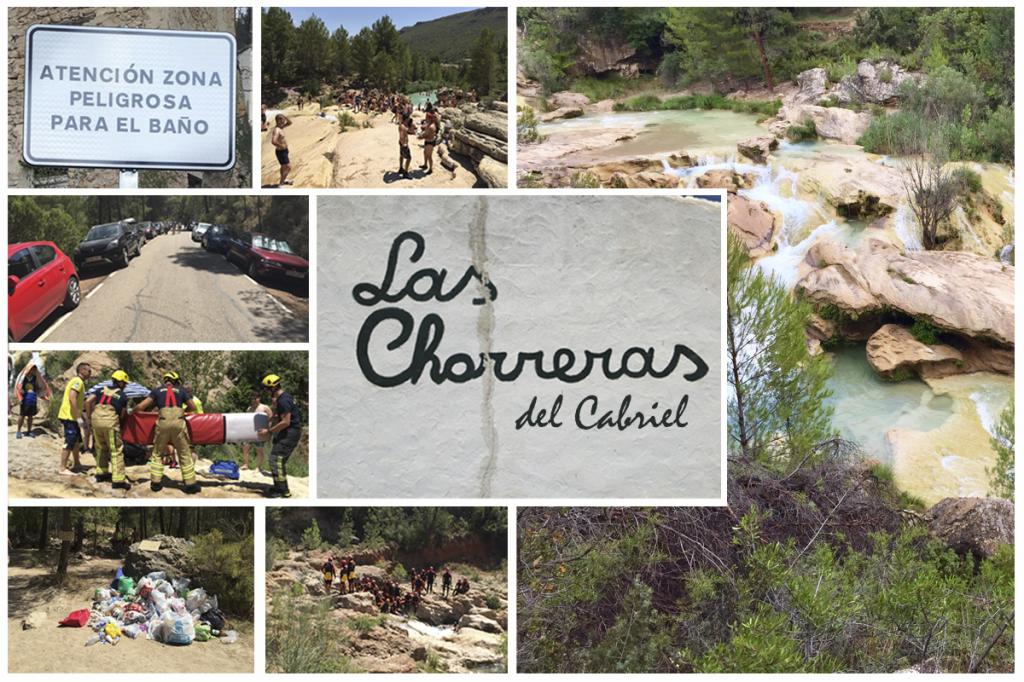
A practical guide on how to visit Las Chorreras of the Cabriel River on the eve of its declaration as a Natural Monument
The natural area known as Las Chorreras of the Cabriel River, which is located between the municipal districts of Enguídanos and Víllora in the province of Cuenca (Spain), has an almost unique natural heritage at a worldwide level. It is a section of the Cabriel River that contains an active tuffaceous system associated with fluvial processes. When we visit this area, we witness how “water becomes rock” thanks to the work of cyanobacteria, microscopic algae responsible for the turquoise color of water. This natural phenomenon began 120,000 years ago, when the Neanderthals dwelt in the Iberian Peninsula. The landscape resulting from this unique geomorphological phenomenon has been responsible for the emergence of important wildlife communities meriting biodiversity conservation within the biogeographical context of the area.
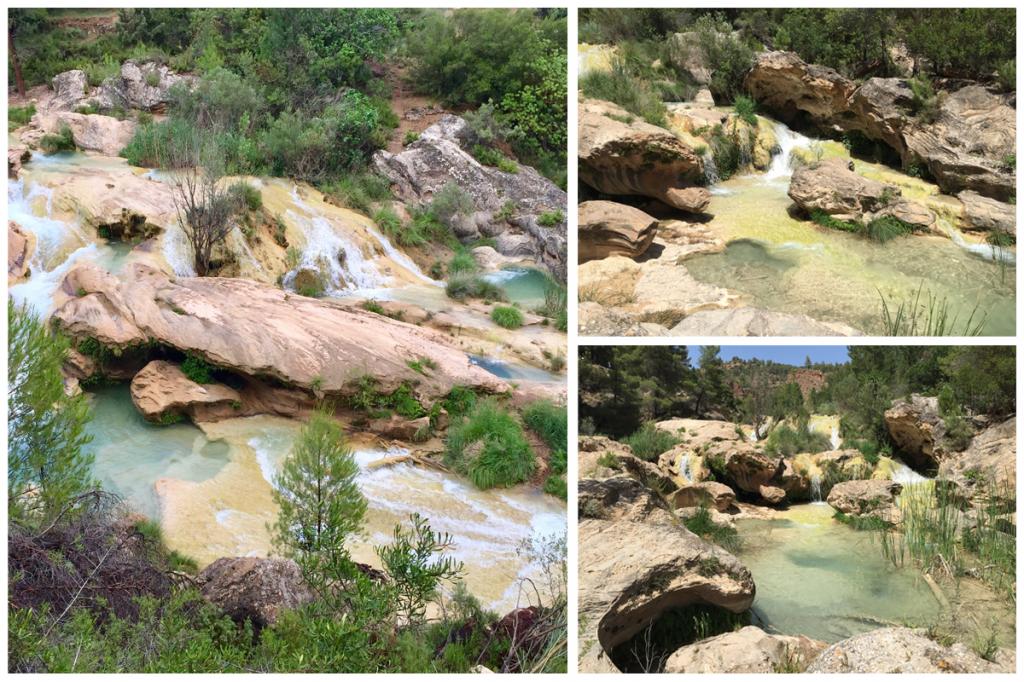
The singularity and beauty of Las Chorreras of the Cabriel River, together with the abundant natural pools and waterfalls that the river has formed over thousands of years, also make this natural area very attractive for tourists, especially in summer, when people visit it to bathe and participate in adventure sports such as canyoning. However, its attractiveness to tourists has also been its downfall over the last 10 years. Las Chorreras of the Cabriel River is currently a very popular tourist destination in summer, and the problems of tourist overcrowding and the associated environmental impacts may be a hazard for its conservation and result in negative psychological impacts for visitors owing to unsatisfactory recreational experiences.
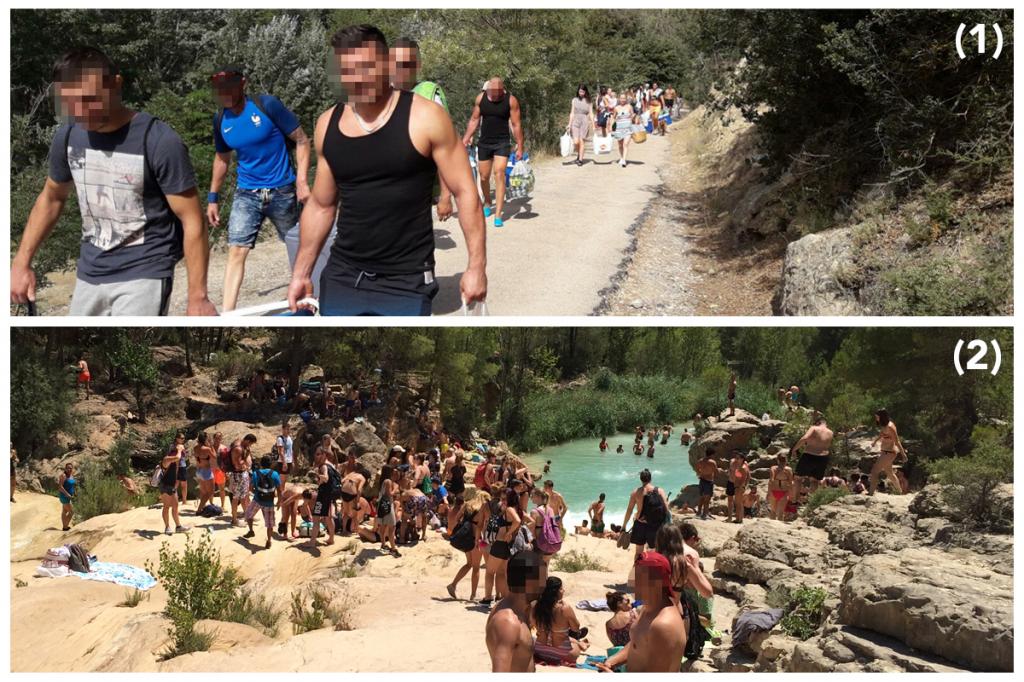
In view of this situation, in summer 2017, the Provincial Directorate of Agriculture, Environment and Rural Development of the Regional Government of Castilla-La Mancha (JCCM) began the process of declaring Las Chorreras a Natural Monument, a level of environmental protection that will allow the regulation of its public use in order to make it compatible with the conservation of natural heritage and local socioeconomic development. This process required a scientific-technical study to characterize the current public use of the area, which we developed together with our professional firm Stipa Environmental Consulting. The results from this work, during which we applied the principles of Recreation Ecology, together with other complementary reports, will serve to establish the regulations that will guarantee the sustainable public use of the future natural protected area.
Though the declaration of the Natural Monument of Las Chorreras of the Cabriel River will very soon be a reality, the regulation that will ensure its sustainable public use will still not apply during summer 2018. We, therefore, consider it highly appropriate to provide some basic recommendations on how to visit this fantastic natural area and how to behave whilst there. In the absence of the forthcoming specific regulation, these recommendations are based on the results of the above-mentioned reports and the general rules established by the regional and municipal legislation on natural heritage conservation, the recreational use of natural areas, the development of active tourism activities, and traffic safety.
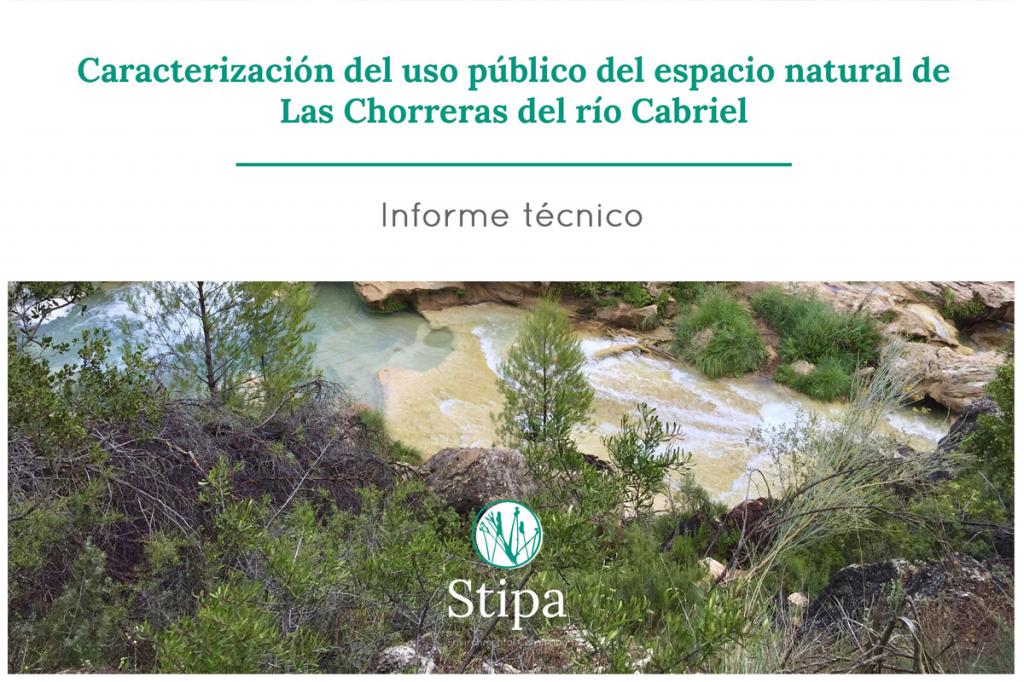
First of all, some key aspects regarding safety…
It is dangerous to bathe and do adventure sports in and around Las Chorreras! ⇒ The area in which Las Chorreras is located is about 1200 meters downstream of the Víllora Dam, which is associated with the “Lucas de Urquijo” Hydroelectric Power Plant. This means that the water flow at this point depends on the hydroelectric power plant operations, signifying that on some days there is a stronger and more violent water flow than on others. Furthermore, a breakdown of the dam or an unexpected storm (among other causes) might lead to an important and sudden increase in the water flow that would sweep away everything in its path. This, along with the rough features of the river course and its surroundings, make Las Chorreras a dangerous area in which to bathe and participate in adventure sports. Furthermore, you must be aware that Las Chorreras area is not listed as an “authorized fresh water bathing area” by the JCCM. If you visit Las Chorreras and decide to refresh yourself in a natural pool, you must know that you do so at your own risk and must assume any hazard related to the presence of the dam and the characteristics of the river and its surroundings.
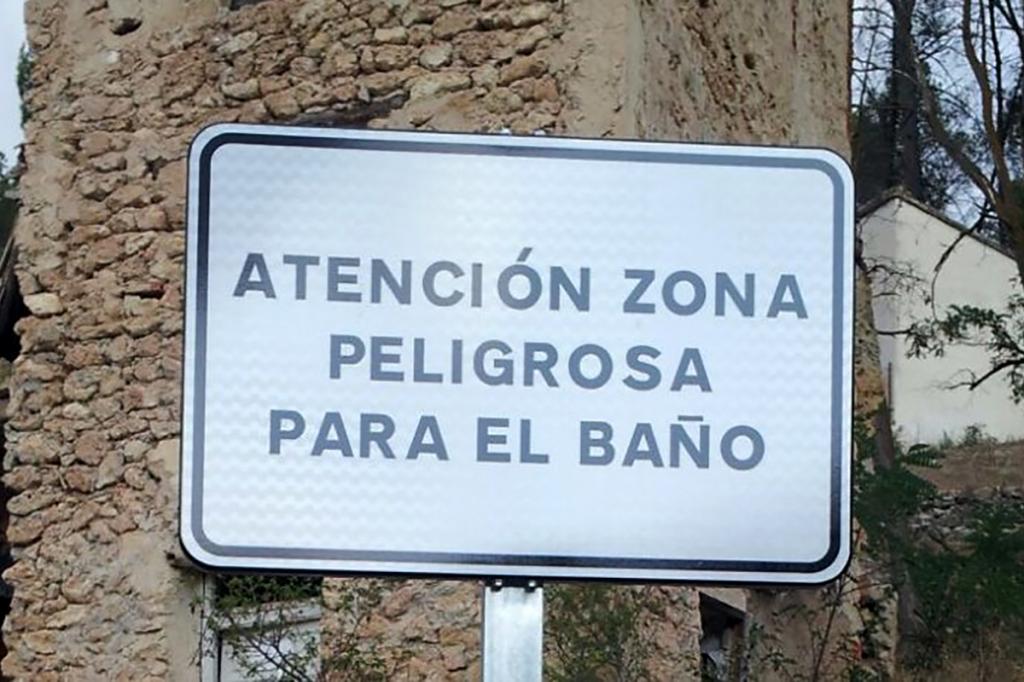
Don’t do stupid things! ⇒ Las Chorreras area is full of beautiful waterfalls and pools surrounded by impressive tuffaceous formations. But refreshing oneself in the Cabriel River or delighting in the marvels of the zone doesn’t mean that you should take unnecessary risks. Going along dangerous paths, walking through waterfalls, diving into the water from the highest rock or canyoning wearing a bathing suit and sandals are completely irresponsible acts in an area like Las Chorreras. Committing this kind of imprudent acts is the reason for 100% of the numerous accidents registered every year in this natural area. In this respect, you must consider that there is no medical aid or health care station and that mobile phone coverage is low or even non-existent, meaning that you must call the emergency service in Cuenca (112) in the event of an accident.
Don’t leave the main paths or the bigger pools ⇒ Even though they are currently in poor condition, there are several main paths in Las Chorreras that link the most important zones within the area. For those who decide to take a swim, there are some big pools in which the water flow is lower, which allow the river to be enjoyed in a relatively safe way –although not free from the above-mentioned risks–. Because of the rough features of the river course and its surroundings, it is particularly imprudent to leave these main paths or pools, so don’t do it. Furthermore, leaving these paths and pools entails negative impacts on the vegetation and geological formations of the highest ecological value.
The less stuff you carry, the better ⇒ All the things that you need to enjoy a day in Las Chorreras fit in a backpack: some food, something to drink, a camera, a towel (for those who decide to bathe during the visit)… Carrying portable coolers, tables, chairs, insect proof nettings, hammocks, beach umbrellas or any other stuff will just make your access to the natural area more difficult and will increase the risk of suffering accidents.
This place is, perhaps, not recommended for people with reduced mobility ⇒ The rough features of the river course and its surroundings, the relatively poor conditions of the main paths and the absence of upgraded infrastructures suggest that, at least currently, Las Chorreras area is not very adequate for people with reduced mobility.
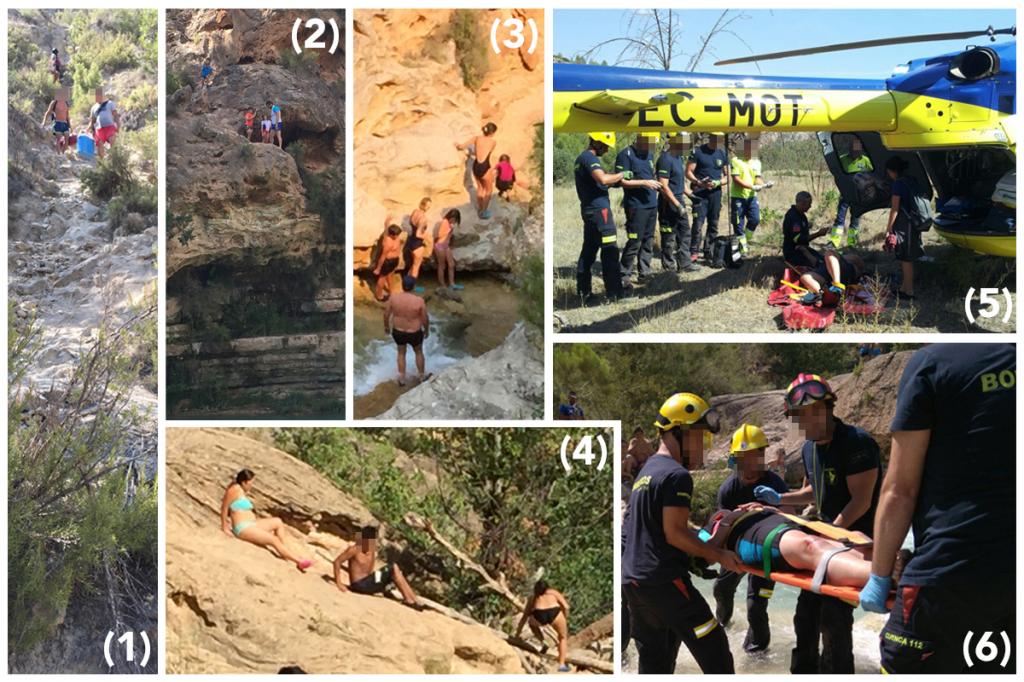
How to visit Las Chorreras?
The area of Las Chorreras is located in the stretch of the Cabriel River surrounding El Salto de Víllora, an old town in which workers at the “Lucas de Urquijo” Hydroelectric Power Plant once lived and that is currently considered as an industrial heritage site. The main access to Las Chorreras is right next to the exit to El Salto de Víllora from the CUV-5014 road, which connects the towns of Enguídanos and Cardenete. At this point, there is a physical barrier that prohibits entry to motor vehicles, and you will, therefore, only be able to reach Las Chorreras by walking or biking along the 900-1000 meters between the barrier and the Cabriel River through El Salto de Víllora.
The distance between Cardenete and El Salto de Víllora (about 12 kilometers) or Enguídanos and El Salto de Víllora (about 5 kilometers) motivates most visitors to reach the area in their vehicles. But this is a problem: once visitors reach the exit to El Salto de Víllora and find the physical barrier, there is nowhere to park. This leads people to decide to park their vehicles in ditches along the side of the road, which is forbidden, is subject to sanctions by the authorities, and creates road safety problems. Enguídanos Town Council is working to provide a parking area near the barrier at the exit to El Salto de Víllora, but it may not be ready for use in summer 2018.
Given these circumstances, the best choice as regards visiting Las Chorreras includes reaching Enguídanos, parking our vehicles at the parking areas provided for that purpose (the forecourt of “La Cooperativa”), and then choosing between the following options:
- Making use of the bus service set up by Enguídanos Town Council. This departs from and arrives at the forecourt of “La Cooperativa”.
- Taking advantage of hiking or biking through the “PR-53 of Las Chorreras” in order to enjoy Nature. This is a short route of about 4.5 kilometers that follows the course of the Cabriel River, starting in Enguídanos and leading to Las Chorreras.
The physical barrier located at the exit to El Salto de Víllora from the CUV-5014 road is guarded by the so-called Ecovigilantes, who are the municipal staff that regulate the access to Las Chorreras at this point and contribute to the maintenance of the natural area. If you have any doubts or concerns, they are a good source of information and support. It is also highly recommended that you contact the Tourism Information Office in Enguídanos to ask for any kind of detailed information, even in advance, since it will allow you to plan your visit adequately.
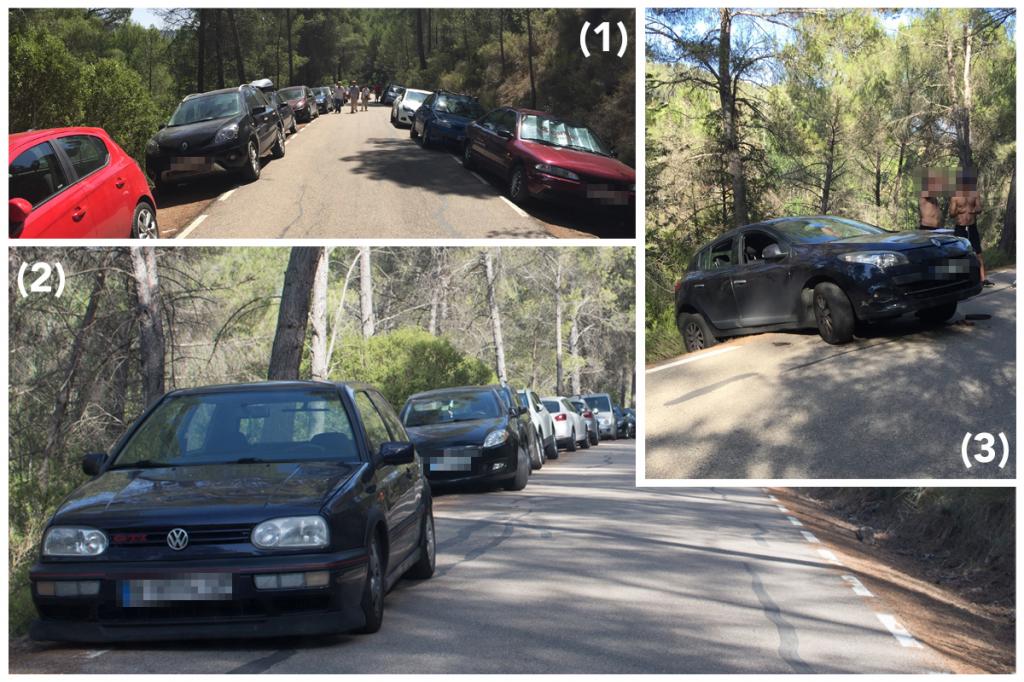
How to behave during your visit to Las Chorreras?
Don’t dump or hide your waste, take it with you ⇒ The presence of garbage is one of the most common and notorious environmental impacts in natural areas in which visitors tend to concentrate, and this is also true of Las Chorreras. This not only has negative effects on the soil, water quality and wildlife, but also on the visitors’ recreational experience. Moreover, it may create public health problems. DON’T BE SUCH A SLOB! Keep your waste (all and of any type) and take it with you at the end of your visit. There are trash containers near the physical barrier at the exit to El Salto de Víllora from the CUV-5014 road and near the forecourt of “La Cooperativa” in Enguídanos.
Don’t smoke or make fires, or use any fire-producing devices ⇒ Legislation on forest fire prevention and fighting define summer as a “high-risk period for forest fires”, which implies the prohibition of smoking, making fires and using fire-producing devices in natural areas. Furthermore, cigarette filters contain highly contaminant residues: when they are thrown onto the floor or into water they release toxic substances, and one single filter can contaminate about 50 liters of water.
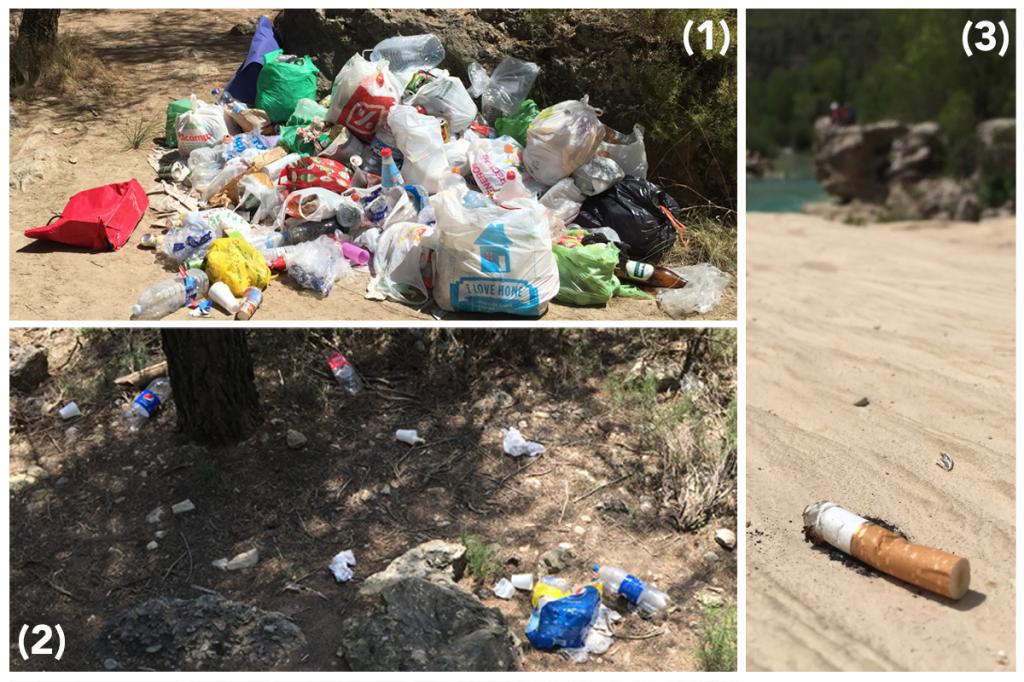
Use the public WC ⇒ When you reach Las Chorreras through El Salto de Víllora you will find a picnic area, and next to it, a zone where Enguídanos Town Council will try to provide several portable WCs. If they are available, use them. It will positively contribute to keeping the area clean and healthy.
Keep your noise level down ⇒ The use of music devices and screaming may disturb wildlife and other visitors. Remember that you are visiting a natural area, and that the sounds of Nature here are more valuable than roaring laughter and the catchiest tunes.
Don’t use too many creams or any other kinds of body lotions if you plan to bathe ⇒ If you decide to bathe, you should know that creams and other body lotions alter the appearance of the water and contaminate it. It is important to prevent sunburn, but remember that you are visiting one of the cleanest rivers in Europe. Do not contribute to changing this.
If you take your dog with you, keep it on a lead or closely controlled ⇒ Dogs running loose may cause damage to or problems for wildlife and other visitors. If your dog is not really quiet nor is always by your side, keep it on a lead. In any case, picking up its droppings will positively contribute to keeping the area clean.
Free camping is not permitted ⇒ As a general rule, free camping –the installation of tents, caravans or other similar elements in natural areas– is not permitted in Castilla-La Mancha, and camping during a journey –the installation of tents for one night– requires the approval of the JCCM.
Don’t damage or plunder the geomorphological heritage ⇒ Tuffaceous rocks and fossils are vulnerable to anthropic degradation caused by constant trampling and plunder. Furthermore, the active zones of the tuffaceous system associated with the river –where new rock layers are formed naturally–, which are located in waterfalls, fluvial ramps and slides, are particularly sensitive: when stepping on them, the recently formed layers of rock are destroyed and the whole system is disturbed. Rocks, fossils and the natural processes that form Las Chorreras are the essence of its natural richness. Avoiding leaving the main paths or river pools, and avoiding stepping on waterfalls and other geological formations will contribute to conserving the zones of the system that are of the greatest ecological value.
Don’t damage the fauna or capture animals ⇒ Outside the legal stipulations established by the legislation on hunting and fishing, any act related to pursuing, capturing or damaging wild animals is forbidden. You are in Las Chorreras inhabitants’ home, and they deserve the same respect as your friends when you visit them at their homes.
Don’t damage the vegetation or gather plants ⇒ Breaking branches, cutting down plants or any other kind of damage to vegetation formations are forbidden. The plants inhabiting Las Chorreras are part of Habitats of Community Interest and are the key to preserving biodiversity in the area.
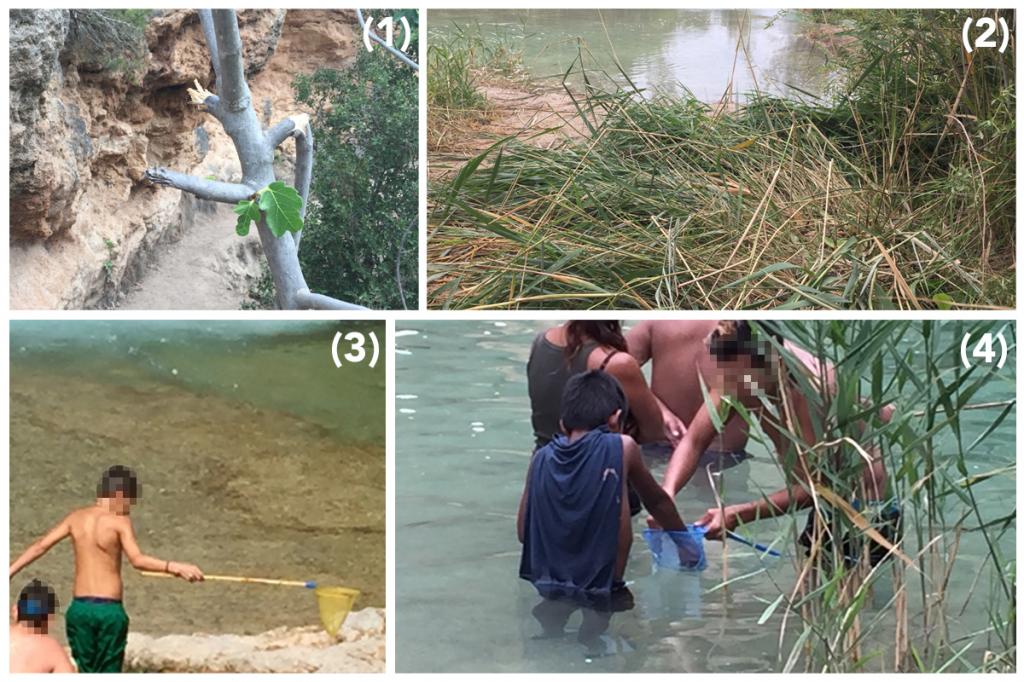
Caring for Las Chorreras is also a responsibility for visitors who are canyoning ⇒ In this natural area, canyoning is mostly done by groups of visitors who contract active tourism companies. Because of its intrinsic characteristics, this adventure sport may have important impacts on the active zones of the tuffaceous system. If you are an instructor or a participant in a canyoning activity, you can make a positive contribution to the preservation of Las Chorreras. Take care not to step on waterfalls, ramps and slides, or walk through them: it is here that the new layers of rock are being actively formed. Take care not to make too much noise: this may bother wild animals inhabiting the area and other visitors. And take care not to overcrowd the river course: respect a waiting time of 1 hour between the entrance of every canyoning group into the ravine, and don’t form groups of more than 15 participants. Don’t forget that only the active tourism companies registered in the Municipal Registry of Enguídanos are allowed to do canyoning in Las Chorreras after making an appointment in advance through the Tourism Information Office in Enguídanos.
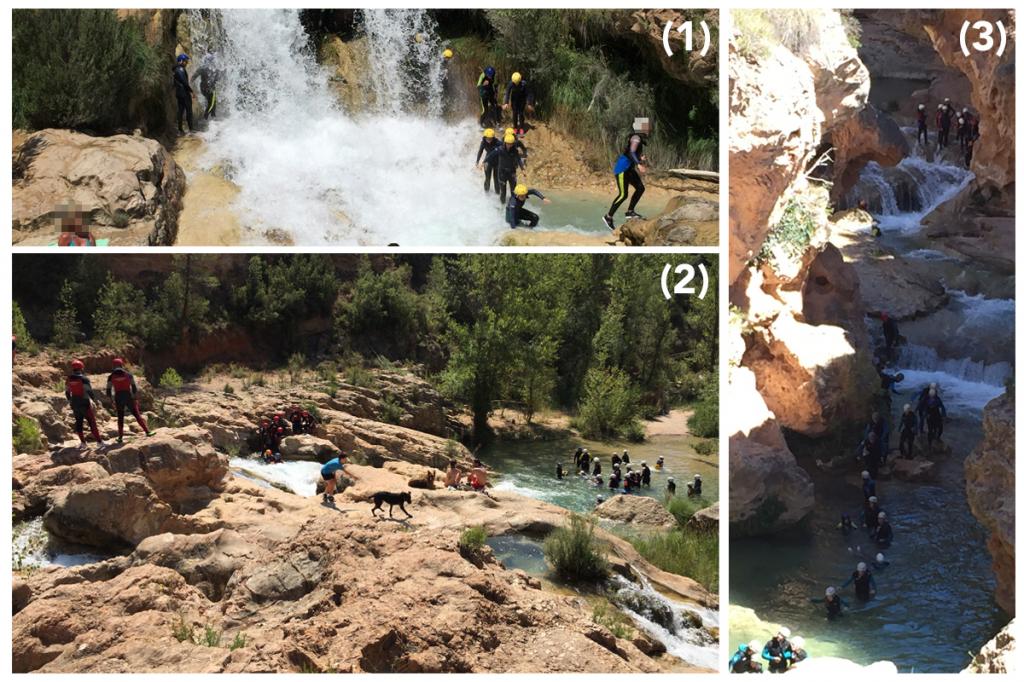
VISITORS! The conservation of Las Chorreras of the Cabriel River is in your hands. For the good of this natural area, for your own and for the common good of all, LOOK AFTER IT!
Are you interested in Environmental Sciences and Science communication?
Subscribe to our Newsletter at the end of our website!
Are you a scientist in the field of Environmental Sciences and would like to disseminate the results of your work in Divulgazeral?
Contact us in info@azeral.es!

